#Daguerreotype process
Explore tagged Tumblr posts
Text





#ebay#books#new-york mirror#1839-1840#1830s#1840s#daguerreotype#daguerreotype process#marbling#marbled paper
9 notes
·
View notes
Text




—
History of World Photography Day
The first World Photography Day took place on 19 August 2010.
A curated online photograph gallery launched the event. The gallery showcased the works of 250 photographers, and viewing hits came from over 100 countries.
You may be wondering: why do we celebrate World Photography Day on August 19?
On this date in 1939, the French government purchased a patent for the Daguerreotype process.
Louis Daguerre (18 November 1787 – 10 July 1851) developed this groundbreaking photography process, which was later offered free to the world via the patent.
Unlike modern-day photographs, daguerreotypes were cast onto solid metal plates. It was the first commercially successful photography system.
For many photographers, it was the turning point and the subsequent creation of many types of photography.
Credit: Sprout Social
#World Photography Day#Daguerreotype process#daguerreotype#Louis Daguerre#British Royal Family#Royal Collection Trust
0 notes
Text
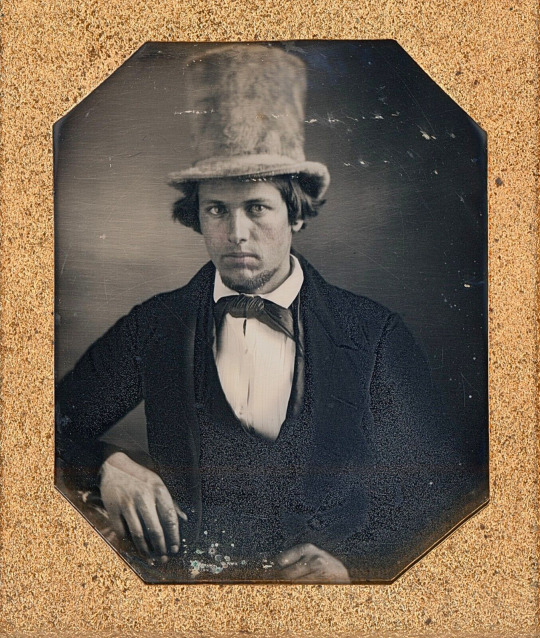
Daguerreotype of a gentleman with a serious expression and a fantastically unserious furry top hat, c. 1850s
#I want to stroke his furry stovepipe and it’s probably more obscene that I don’t mean that as a euphemism#I mean LOOK AT IT! I am in awe#early top hats (aka stovepipe hats) WERE made of fur—ideally beaver—but felted and processed to smoothness#not this amazing fuzzy wuzzy wtfuckery#19th century#1800s#1850s#1850s fashion#19th century fashion#men's fashion#menswear#historical fashion#fashion history#19th century photography#daguerreotype#19th century men#vintage men
251 notes
·
View notes
Text
The Evolution of Photography
From Daguerreotypes to Digital Delights Once upon a time, in a world devoid of selfies and Instagram, photography was born. It’s been a wild ride from the first grainy images to the high-definition snaps we casually scroll through today. So, grab your camera, and let’s zoom in on the history of photography. The Dawn of Photography It all started with a bang—or more accurately, a click. The early…

View On WordPress
#art form#color photography#daguerreotype#digital photography#Instagram#negative-positive process#photography history
0 notes
Text
Yeah, no, the original subject of this silly little vent post crossed my dash again, and I can no longer rise above it.
That's not Jartnell!
How has he made it to the final that delightful wee poll when it's not even him!!!
I want to be a hater about something right now but I'm rising above it and I think that's very brave and sexy of me.
#Vent post I guess?#In all seriousness I know it's just a bit of fun and it's not that deep#I'm not intending to come for anyone and hope no one comes for me#But yeah#I'm no expert on photographic processes but they are in my professional wheelhouse as a conservator#And I say with almost complete certainty that that can't possibly be a daguerreotype of Jartnell because it isn't even a daguerreotype#It looks much more like an albumen or possibly a collodion print to me#Both processes that weren't invented pr widely available until several years after Jartnell was cold in the Arctic ground#I'm no longer brave or sexy about this I'm sorry
9 notes
·
View notes
Text
[Connect 4 FIC] Mementos
Fandom: The Sandman Pairing: Dreamling Rated: G Word Count: 1243 Tags: fluff, pre-relationship, future fic, photography
Notes: For the @sandman-connect4 prompts Goldfish and Photography
Summary: Hob waxes nostalgic about an old hobby that's also his newest career.
On AO3
"Photography is such an amazing innovation, yeah?" Hob snaps another photo as he speaks, capturing the elegant swish of orange and white fins just breaking the pond's surface. "Still marvel over it, sometimes, used to it as I am."
"Indeed." Dream is drifting along at Hob's side, interested and attentive, and Hob knows by now that no one nearby will pay any attention to his ramblings so long as Dream is here with his notice-me-not aura. He's free to speak of whatever he likes without fear of being overheard.
"Couldn't imagine, first I heard of it—a device to take your portrait, without having to sit for a painter? Unthinkable! But it was true!" He snaps another pic as a particularly elegant fantail wriggles past a lily pad. "Couldn't wait to get a daguerreotype taken; I still have it, stored away for safekeeping, along with every other portrait I had done in the nineteenth century. They just kept refining and improving on the process—it was amazing, y'know? How marvelous, this ability to capture an image exactly as seen, and it just kept getting better. Had plans to show you the latest I'd had done at our meeting in 1889, if I hadn't put my foot in it first." He snaps another photo, two fish swimming past one another in a graceful floating of fins, and keeps right on talking before Dream can offer any commentary on that particular phase of their friendship. It's water under the bridge, done and gone and forgiven and he doesn't need an apology every time it comes up.
"And then personal-use cameras became a thing, and the tech just kept improving. It was so exciting to have the ability—I could just, y'know, pick up a camera and take pictures of whatever I liked! Any time! People I'd eventually have to leave behind, I could keep pictures now, if I wanted. Don't always, y'know, I've gotten very good at picking up and moving on when needed and not pulling a bunch of baggage after me, but it's nice sometimes to have those photos there to look back on when the memory starts to fade."
Dream makes a soft sound of agreement as Hob crouches by the edge of the pond, snapping a few rapid-fire shots from the new lower angle.
"And then Polaroids! Didn't even have to send those out, just wait a few minutes and wave it about a bit. Instant pictures. Fantastic. And then digital cameras? Phone cameras? Video, of course? Nowadays everybody's got hundreds of photos in their pocket at any given second, everyone can record or commemorate anything in their life that they want at a moment's notice, and I think that's just brilliant." He grunts as he rises back to his feet, steps away from the perimeter of the pond to capture a wider shot.
"Spent a lot of time on photography as a hobby, middle of last century," he continues as he works. "Amazing how accessible it was. Learned how to develop my own film, which lenses could do what, played with anything I could get my hands on. It was just so cool."
"It was this time as a hobbyist that led you to your current career choice, then," Dream says, in a tone of dawning understanding.
"Yeah, more or less." Teaching had lasted him another decade and a half after Dream's return before he'd needed to pull up roots and reinvent himself, and his old hobby had called to him. "With the trending interest in reviving analog photography it seemed a decent choice after retiring 'Professor Gadling'. Wasn't hard to get hired; most of what I shoot for the magazine's still digital—most of their subscription distribution is digital—but they've got an analog branch catering to collectors and enthusiasts and lucky for me I'm proficient in all of it."
"The luck perhaps belongs to your employer, in securing your skills," Dream offers, with one of those little smiles that Hob so loves to collect. He offers a grin of his own.
"I'll be sure to tell them you said so in my next appraisal."
"And do all of your assignments involve photographing fish?"
Hob laughs. "Nah, course not—it's a lifestyle-and-interest publication; I wind up shooting all sorts of things. This guy's been maintaining his ponds here for decades—probably knew that already, didn't you—and they wanted to do a feature on it. I was chuffed to get the assignment; I've been fascinated by pond building and maintenance for a few years now and I'm pleased to see this fabulous setup in person."
Dream says nothing, studying the pond in uncanny stillness as Hob takes a few more photos.
"Lovely creatures," he says at last.
"Aren't they?"
"They remind me of my sister."
"The one who—?" Hob makes a sweeping gesture with one hand meant to indicate himself and his whole still-alive thing.
"No; the youngest." Dream crouches, dangles fingertips in the water. "They often feature in the way that perception alters around her."
Hob waits to see if anything further is forthcoming, then tucks that small piece of information away to hopefully be expanded upon at a later date. He's learned much about Dream in the last couple decades by paying attention when these little dribs and drabs of personal information are offered and waiting patiently for the next.
He pauses in his photographing, glances sideways down at his friend. "What do their dreams look like, then? Do fish even sleep?"
"Not as such. Not as humans do." Dream wriggles his fingers, once, the surface rippling gently in their wake. "Their dreams are fleeting, gossamer; ephemeral wisps of comfortable waters, of safety, of plenty." There are fish approaching to nibble at Dream's fingertips, orandas and comets and ryukins; Hob watches for a moment then pulls out his phone and snaps a picture, for himself.
Dream catches the change of equipment, glances up with another of those little smiles—indulgent. Hob snaps again, pleased to have proof of that smile, pleased that Dream is present enough in the Waking today to be captured by the camera.
"Oh, look at this fellow," he says, motioning to a large black moor that is swimming up to investigate Dream's fingertips, and slips his phone back into his pocket.
"A beautiful specimen," Dream allows, holding perfectly still while the fish mouths at one finger and then another. "His color is exquisite."
Hob grins. "Must sense a fellow goth in you." He lifts his work camera again, snaps a few of the lovely black fish after Dream has reclaimed his hand.
"Perhaps." Dream's still got that little smile, and Hob remains absolutely delighted to see it.
"C'mon. Let's go see what Mr. Goldfish-Enthusiast has got in his koi pond, over here."
The rest of the afternoon passes pleasantly, more fish photographed, more stories of Hob's past told. And in his pocket, safe in his phone, there are two new pictures of Dream to remind him of his friend when absences stretch long, as they sometimes must. It is comforting, after everything and all these centuries, to know that he's allowed these mementos. He's confident by now that Dream will always return; they have met more in the last twenty years than in the six hundred before and Hob is elated that the friendship he'd recklessly claimed in 1889 has blossomed so wonderfully in truth.
But it's nice he's got the pictures to prove it.
= Started: 11/21/24 Drafted: 11/29/24 Posted: 11/30/24
86 notes
·
View notes
Text
More Art-Related Vocabulary

Abstract Expressionist: An artistic movement of the mid-20th century emphasizing an artist’s freedom to express attitudes and emotions, usually through nonrealistic means.
Age of Exploration (also, Age of Discovery): From the early 15th century to the early 17th century, European ships traveled around the world in search of new trading routes, lands, and partners to supply an ever-growing European market.
Albumen silver print: A photograph made using a process that was prevalent until the 1890s. The paper is coated with albumen (egg whites), and the image is created using a solution of silver salts.
Brayer: A hand roller used for applying ink to relief printing blocks or occasionally for the direct application of paint or ink to a surface.
Caricature: A representation in either literature or visual art that includes a ridiculous distortion or exaggeration of body parts or physical characteristics to create a comic or gross imitation.
Ceramics: Vessels of clay made by using a variety of shaping techniques and then hardening or firing the clay with heat at a high temperature.
Chasing: A term encompassing two processes in metalworking: (a) modeling decorative patterns on a hand-shaped sheet-metal surface using punches applied to the front, and (b) finishing and refining a cast sculpture.
Classical: Describes a prime example of quality or “ideal” beauty. It often refers to the culture, art, literature, or ideals of the ancient Greek or Roman world, especially that of Greece in the 4th and 5th centuries B.C.
Collage: An art form and technique in which pre-existing materials or objects are arranged and attached as part of a two-dimensional surface.
Color palette: (a) A set of colors that makes up an image or animation, and (b) the group of colors available to be used to create an image.
Composition: The process of arranging artistic elements into specific relationships to create an art object.
Daguerreotype: An early method of photography produced on a silver plate or a silver-covered copper plate made sensitive to light.
Exoticism: Fascination with and exploration and representation of unfamiliar cultures and customs through the lens of a European way of thinking, especially in the 19th century.
Expressionism: A style of art inspired by an artist’s subjective feelings rather than objective or realistic depictions based on observation. Expressionism as a movement is mainly associated with early 20th century German artists interested in exploring the spiritual and emotional aspects of human existence.
Gelatin silver print: A photograph made through a chemical process in which a negative is printed on a surface coated with an emulsion of gelatin (an animal protein) containing light-sensitive silver salts.
Illuminated manuscript: Comes from the Latin words illuminare (to throw light upon, lighten, or brighten), manus (hand), and scriptus from the verb scribere (to write). A handwritten book, usually made from specially prepared animal skins, in which richly colored and sometimes gilded decorations, such as borders and illustrations, accompany the text.
Illuminator: A craftsman or artist who specializes in the art of painting and adorning manuscripts with decorations.
Impressionist: Referring to the style or theories of Impressionism, a theory or practice in painting in which objects are depicted by applying dabs or strokes of primary unmixed colors in order to evoke reflected light. Impressionism was developed by French painters in the late 19th century.
Inking plate: A flat surface used for rolling ink out in preparation for applying ink to a plate or block.
Inscription: A historical, religious, or other kind of record that is cut, impressed, painted, or written on stone, brick, metal, or other hard surface.
Source Art Vocabulary pt. 1
More: Word Lists
#art related#word list#photography#dark academia#writing reference#spilled ink#writeblr#literature#writers on tumblr#writing prompt#poetry#poets on tumblr#history#studyblr#creative writing#writing inspiration#writing inspo#writing ideas#art#konstantin somov#rainbow#nature#art vocab#writing resources
107 notes
·
View notes
Text
“The first selfie was taken by Robert Cornelius (USA) in October 1839, using a daguerreotype technique – an early photographic process employing an iodine-sensitized silvered plate and mercury vapour. Cornelius was required to sit for between three and 15 minutes to allow the necessary exposure time.”

54 notes
·
View notes
Text
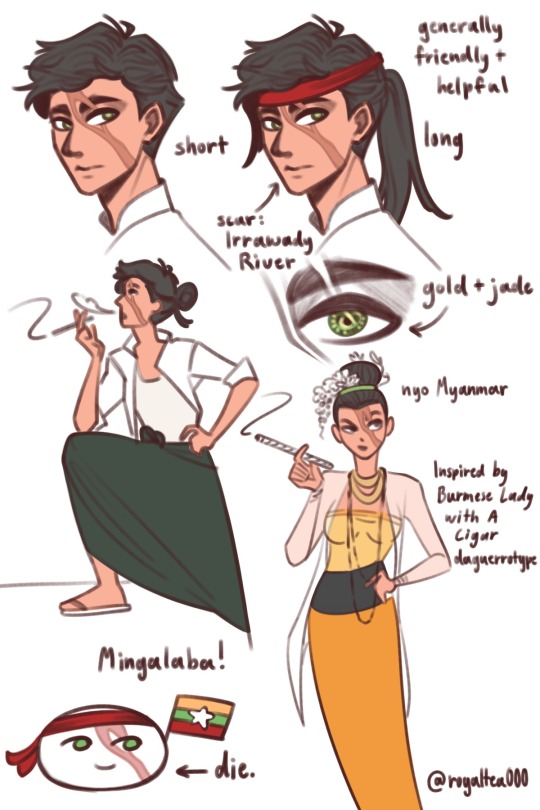

Myanmar Hetalia OC
design explanations under the cut :p
I am Burmese myself so all of this is influenced mostly by my own experience and by family and friends around me :)
The Irrawaddy River scar is more of a birthmark I just forgot the word for it. My mom would constantly tell me that when she was little the Irrawaddy River was clear and full of little green and blue stones and the elders tell me that you could scoop a bunch of them in a jar and most of them would be turn out to be precious stones. That’s where the inspo for the eyes came from cuz in my mind, because of these stories (and the numerous amounts of jade and amber jewelry I get sent every year), Myanmar will always seem like a very rich land with a foundation of gold to me. If you were on hetalia deviantart in the early 2010s you probably know what the long hair with headband version is inspired by -w- the overall design tho is just the most common looking Burmese guy I know lol
btw THIS is the daguerreotype of a Burmese lady with a cigar I was inspired by!! Isn’t she so cool??!
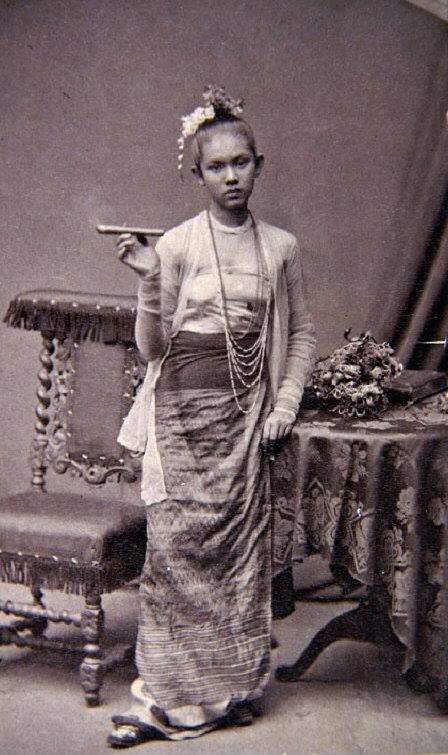
I kinda wanna do personifications of the different states as well in the future. I am specifically from the Kachin state so I drew a quick draft of him at like 2am @w@
I’ve always had kind of a takin the piss out of it relationship with my culture and with the coup and civil war goin on over there right now it is a little difficult to feel any pride about it, worrying over if my family is alright over there. I’ll be honest this started out as a little thing I thought would be kinda silly to do but I found in the process that it was kinda. Therapeutic? Soothing?? I dunno. Gathering all my experiences and knowledge into making one personification made me remember all the good experiences I had being Burmese and made me appreciate it more funnily enough :)
#I feel like I put a lot more love than usual into this#I’m kinda embarrassed by that lol#And I feel so vulnerable in this Chili’s tonight 😩#hetalia oc#hetalia asean#hws asean#hetalia myanmar#hetalia#hetalia world stars#historical hetalia#hetalia fanart#digital art#my art#commissions open#artists on tumblr#procreate#original character#original art#i feel like I have to make this clear#I am not spreading propaganda of any kind this is just me expressing my own experiences and culture through my art#None of this is meant to be disrespectful#You never know man there’s some real dumbasses out there these days#Wow this is the longest post I’ve ever made I think#Hetalia Asia#Aph Myanmar
123 notes
·
View notes
Text
I think that modernity started on August 2, 1839, when Daguerre first publicly demonstrated the daguerreotype photographic process.
26 notes
·
View notes
Text
Because I had headcanon that Color is Autistic and has developed special interests in things such as photography, travel, maybe even things like social advocacy.
Maybe even philosophy and psychology. For now, in this posts, I’ll focus on the big two: photography and traveling. (I will also touch on how Color’s physical disability, chronic fatigue, his autism, and perhaps his ptsd/ separation anxiety from Killer also effect his ability to engage in his interests in another post.)
I think he’d develop some decent if not above average technical knowledge, such as camera types and functions. Detailed understanding of different types of cameras (DSLR, mirrorless, point-and-shoot, medium format, etc.) and their specific functions.
Knowledge about various lenses (prime, zoom, wide-angle, telephoto, macro) and their applications. Mastery of camera settings like ISO, aperture, shutter speed, and how to manipulate them for different lighting conditions and artistic effects.
In-depth understanding of how aperture, shutter speed, and ISO interact to create a properly exposed photograph. Proficiency in using software like Adobe Lightroom, Photoshop, or other photo editing tools for post-processing and enhancing images.
He’d learn about artistic elements such as composition techniques, lighten and color theory. Develop a familiarity with compositional rules like the rule of thirds, leading lines, framing, symmetry, and how to creatively break these rules.
Knowledge about natural and artificial lighting, how to use light to create mood and depth, and techniques like backlighting, side lighting, and using reflectors. Understanding of how colors interact, complementary colors, and how to use color to convey emotion and direct viewer attention.
Awareness of different photography styles (portrait, landscape, macro, street, documentary, astrophotography, etc.) and genres, and what makes each unique.
Knowledge about influential photographers and their work, such as Ansel Adams, Henri Cartier-Bresson, Annie Leibovitz, and contemporary photographers.
Understanding the evolution of photography, from daguerreotypes to digital photography, and significant milestones in the field. Awareness of current trends in photography, popular styles, and emerging technologies.
And, of course, he’d develop and grow practical experiences and hands on practice. Experience with on-location shoots, managing different weather conditions, and adapting to various shooting environments.
Knowledge about how to properly maintain and clean camera equipment to ensure longevity and optimal performance. Skills in troubleshooting common issues like lens flare, sensor dust, or focus problems.
He’d have a deep enthusiasm for specific techniques or subjects he enjoys photographing, whichever or whatever you all think those could be exactly.
Likely to have personal photography projects, well-organized portfolios, and possibly an online presence showcasing their work. Extensive collection of books, articles, videos, and tutorials related to photography.
A special interest in traveling, in addition to photography, would manifest in the character in several ways, showcasing their passion and extensive knowledge about various aspects of travel. Here are some specific aspects:
For his interest in travel, he’d be very well versed in the planning and research process. Color might create comprehensive travel itineraries, meticulously planning each day's activities, routes, and schedules.
He might gradually develop an extensive knowledge about various travel destinations, including historical sites, natural landmarks, cultural attractions, and lesser-known gems.
He’d display a proficiency in booking flights, accommodations, and transportation, as well as understanding visa requirements, travel insurance, and local regulations.
An expertise in packing efficiently, knowing what to bring for different climates and activities, and how to pack photography gear safely for travel. Color is likely to show a very deep and profound appreciation for different cultures, learning basic phrases or even fluency in multiple languages to better communicate while traveling.
He’d definitely show a deep interest in trying and understanding local cuisines, knowing popular dishes, and even recipes from various regions. He’d have at least some knowledge about local customs, traditions, festivals, and etiquette to respect and immerse themselves in different cultures.
He’d certainly develop some geographical and historical knowledge, with a detailed understanding of world geography, maps, and the ability to navigate using traditional maps as well as digital tools.
Knowledge about the history of the places he visits, including significant events, historical figures, and the cultural evolution of the region.
He might maintain detailed travel logs or journals documenting his experiences, including photos, notes, and personal reflections. He’d definitely collect souvenirs, postcards, or other memorabilia from his travels; often gifting them to beloved friends.
He’d probably engage with travel communities, forums, and social media groups to share experiences and gain insights.
This special interest would possibly lead to him gaining a lot of practical skills, such as in budget management. Expertise in budgeting for travel, finding deals, and managing expenses effectively.
He might display an ability to adapt to different environments, handle unexpected situations, and problem-solve while on the go.
Although it’d probably be harder for him than most, particularly if he has a harder time handling and dealing with change—especially if the change is unexpected and unplanned.
Knowledge about staying healthy while traveling, such as understanding local healthcare options, vaccinations, and travel safety tips.
He’d like combine both interests by using his photography skills to capture stunning images of the places he visits, creating travel blogs or photo albums to document his journeys.
He might create photo essays or visual stories that capture the essence of the cultures and places he explores. Share his travel experiences and recommendations with others, possibly through writing travel guides, blogs, or social media content.
All this is to say that Killer would definitely encourage Color to come with him to explore abandoned places and ghost towns, and Color’s going to be so overjoyed he starts hand flapping. He’s going to take so many pictures, he’s going to remember it forever.
#utmv headcanons#utmv hc#killer sans#utmv#sans au#sans aus#killer!sans#killertale#othertale#othertale sans#other sans#color!sans#colour sans#color spectrum duo#colorkiller#undertale#undertale au#undertale aus#utmv au#autistic headcanon#special interest#undertale something new#undertalesomethingnew#something new#something new sans#something new au#killertale sans#canon disabled character#bad sanses#bad sans gang
36 notes
·
View notes
Text










Milestone Monday
On August 19, 1839, the French government announced that the patent it had acquired for Louis Daguerre’s, (1787-1851) photographic process, the daguerreotype, was a gift “free to the world” marking the first publicly available method of photography and sparking ages of modification and advancement within the medium. In 2010, August 19th was named National Photography Day, a celebration of the art, technology, and history of photography.
In celebration of the day, we’re sharing a recent acquisition to our photobook collection Midwest Materials by Missouri photographer Julie Blackmon (b. 1966). Published by Radius Books in 2022, Midwest Materials features Blackmon’s fictitiously ethnographic color photographs of domestic life in Springfield, Missouri. In the introduction, journalist Leah Ollman describes Blackmon’s work as “serious mischief,” an evocation deeply felt in her vibrant scenes capturing the innocence and theatrics of childhood.
Read other Milestone Monday posts here
– Jenna, Special Collections Graduate Intern
#milestone monday#national photography day#louis daguerre#daguerreotype#midwest materials#julie blackmon#radius books#leah ollman#photography#photobooks
47 notes
·
View notes
Text

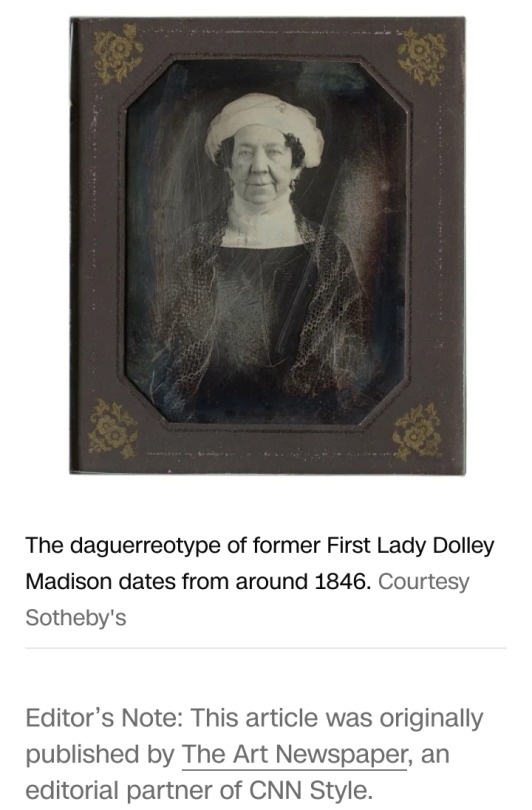







—
Dolley Todd Madison (née Payne; May 20, 1768 – July 12, 1849) was the wife of James Madison, the fourth president of the United States from 1809 to 1817.
She was noted for holding Washington social functions in which she invited members of both political parties, essentially spearheading the concept of bipartisan cooperation.
Previously, founders such as Thomas Jefferson would only meet with members of one party at a time, and politics could often be a violent affair resulting in physical altercations and even duels.
Madison helped to create the idea that members of each party could amicably socialize, network, and negotiate with each other without violence.
By innovating political institutions as the wife of James Madison, Dolley Madison did much to define the role of the President's spouse, known only much later by the title First Lady — a function she had sometimes performed earlier for the widowed Thomas Jefferson.
—
James Madison (March 16, 1751 – June 28, 1836) was an American statesman, diplomat, and Founding Father who served as the fourth president of the United States from 1809 to 1817.
Madison was popularly acclaimed the "Father of the Constitution" for his pivotal role in drafting and promoting the Constitution of the United States and the Bill of Rights.
#The Smithsonian#National Portrait Gallery#US First Lady Dolley Madison#US President James Madison#quarter-plate daguerrotype#daguerreotype#John Plumbe Jr#Sotheby's#Louis Daguerre#photographic process#photography#first lady#1800s#19th century
3 notes
·
View notes
Text
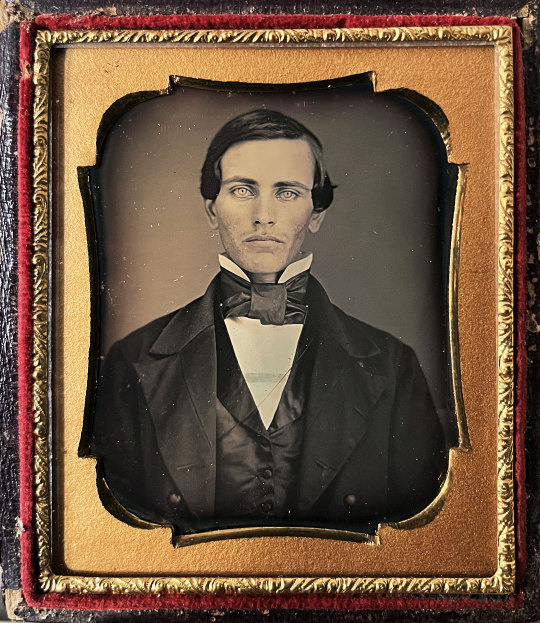
Daguerreotype of a handsome youth with haunting eyes, circa 1850
#the wet plate process makes blues come out lighter so it is possible that this man's eyes were not quite this intensely pale irl#but what an incredibly striking effect! his name is unrecorded but here he is 170 years on staring into your soul#19th century#19th century fashion#19th century photography#daguerreotype#historical fashion#fashion history#men's fashion#1800s#1850s#this is probably my favorite piece from my own collection#absolutely nail-biting auction#my collection
128 notes
·
View notes
Text
Through this patrons only essay, I think through the way surface both retains and exceeds Blackness, stretching from the epidermis to pornotropic Black geographies.

Delia daughter of Renty on B.F. Taylor Plantation, Columbia South Carolina [Picture # 1]
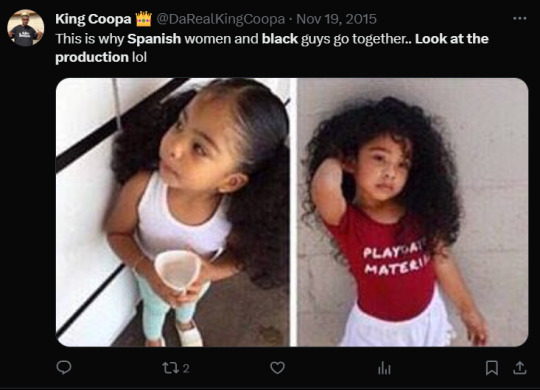
[ID] @DaRealKingCoopa tweets: "This is why Spanish women and black guys go together...Look at the production lol" There are two photographs of two light skinned little girls below the tweet. The little girl on the left is holding a crushed paper cup and looking to her right. The little girl on the left is lifting her hair. She wears a red shirt that reads "PLAYDATE MATERIAL". [end of ID]
The daguerreotype and screenshot above best visually describe the essay. Here are some excerpts:
There needs to be a Black body whose epidermis is weighed down with meanings for Blackness to register as legible. Louis Agassiz commissioned daguerreotypes of Delia and Drana amongst others to surface what he considered black inferiority; as it was, there was (and is) nothing to be said, almost nothing to be seen. There's nothing to be retrieved from the surface, for there isn't any meaning to it.
and
How does one settles through the contradiction ? How it is that the surface can hollow and index ? What about the Black epidermis means countability without recognition ? The archive begets the algorithm. The algorithm begets the archive. PredPol, a company producing predictive policing software, rests on the surface of the event. The type of crime. The time of the crime. The location of the crime.
and
@DaRealKingCoopa tweets: "This is why Spanish women and black guys go together.. Look at the production lol" . The (re)produced girl children stand silent, growing more opaque as @DaRealKingCoopa imbricates the skins of body in flux. Through the dreamed introduction and the material disappearance of his extremity, he participates in a process, that would, by proxy, identifies his body as obsolete and defaced, a debris to be rid of for the surfacing to occur in all its quaint neatness. He would no longer exist as he is; the fleshy brand of his abjection would rub up against the sandpaper of a deracialized "Spanish" woman, peeling off into unidentifiable children. Now you see me, now you don't.
65 notes
·
View notes
Text

Sara Imloul (FR, Mulhouse, 1986)
Le Cordon Passages, (2015-2018, série primée), Mixed media, calotype, gelatin silver contact print on baryta paper, enhanced with ink, pencil and ferricyanide. 13x18 cm, edition of 7
Calotype or talbotype is an early photographic process introduced in 1841 by William Henry Fox Talbot, using paper coated with silver iodide. This process uses a paper negative to make a print with a softer, less sharp image than the daguerreotype.
https://www.saraimloul.com/passages
10 notes
·
View notes